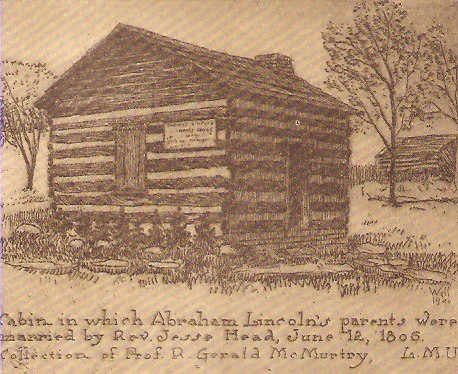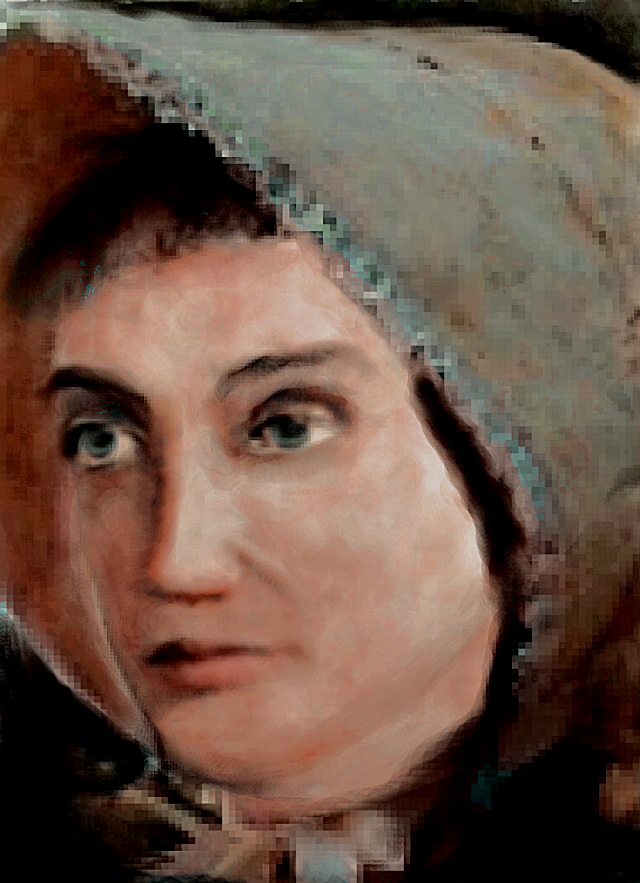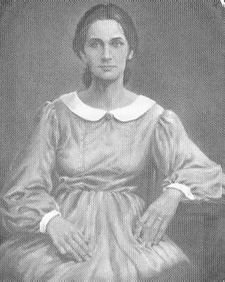|
|
|
The drawing to the left depicts the home of Richard Berry where Thomas Lincoln and Nancy Hanks were married at sunset on June 12, 1806. The photograph to the right depicts a reassembled replica of the cabin purported to be Abraham Lincoln's birthplace. Lincoln was born about dawn on Sunday, February 12, 1809,
in Hardin County (now LaRue County) near Hodgenville, Kentucky.
|
|
|
On June 10, 1806, Thomas Lincoln of Hardin County, Kentucky, traveled to the Washington County Courthouse to obtain a bond to marry Nancy Hanks. Two days later the wedding took place in Richard Berry’s cabin located close to Beechland in Washington County, Kentucky.
Reverend Jesse Head, a minister in the Methodist Episcopal Church, performed the ceremony in the evening after a day of festivities. Dr. Christopher Columbus Graham, who attended the wedding, stated that the food included bear meat, venison, wild turkey and ducks, eggs, maple sugar strung on a string to bite off for coffee and whiskey, syrup in big gourds, peach and honey, and a sheep that two families barbecued over coals and wood burned in a pit.
The Lincolns settled in Elizabethtown, and they celebrated the birth of their first child, Sarah, on February 10, 1807. In 1808 the Lincolns moved to the Sinking Spring Farm located on the south fork of Nolin Creek, around two and a half miles from Hodgenville, Kentucky. Their cabin measured approximately
16 by 18 feet. The logs were oak and chestnut and numbered approximately
143. They were chinked with clay. Rough wooden shingles covered the roof.
There was a stone fireplace, one door which swung on leather hinges, and one
window (without glass) which was once covered with greased paper or thin
animal skin. There was a small box-like stick and clay chimney. The floor
was dirt.
In 1808 Nancy became pregnant for the second time. During the afternoon of Saturday, February 11, 1809, Nancy told Thomas that the time was getting close. She asked Thomas to get a midwife. Thomas left the cabin, and when he reached the road he saw a neighbor, Abraham Enlow (then 16 years old). Enlow's mother was a local midwife. Enlow told Thomas to go back and wait with his wife, and he promised to send his mother, and if she couldn't come, he would get his half-sister Margaret "Peggy" La Rue Walters (wife of Conrad Walters). As it turned out, Peggy Walters was the one who returned to the Lincolns' cabin. Abraham Enlow took Peggy Walters to the Lincolns' cabin. Peggy was only 20 years old, but she had assisted her mother with other births in the area.
Many years later, in the summer of 1864, a neighborhood picnic took place near the location of the old Sinking Spring Farm. The picnic was on the property of a man named Richard Creal. During the picnic the conversation turned to the fact that President Abraham Lincoln had been born on the very land where the picnic was being held. One of the older women, Peggy Walters, mentioned she was present when Abraham Lincoln was born. She told the following story of the birth:
I was twenty years old, then, and helping to bring a baby into the world was more of an event to me than it became afterward. But I was married young, and had a baby of my own, and I had helped mother, who, as you know, was quite famous as a granny-woman, and I had gone several times to help when I was sent for.
It was Saturday afternoon, I remember, when Tom Lincoln sent over and asked me to come, and I got up behind the boy that rode across to fetch me, and I rode across to the cabin that then stood here. It was a short ride, less than a mile. It was winter, but it was mild weather, and I don't think there was any snow.
If there was any then, it wasn't much, and no snow fell that night. They sent for me quite as soon as there was any need, for when I got there nothing much was happening. They sent for her two aunts, Mis' Betsy Sparrow and Mis' Polly Friend, and these both came, but they lived about two miles away, so I was there before them, and we all had quite a spell to wait, and we got everything ready that we could.
They were poor folks, but so were most of their neighbors, and they didn't lack anything they needed. Nancy had a good feather-bed under her; it wasn't a goose-feather bed, hardly anyone had that kind then, but good hen feathers. And she had blankets enough. There was a little girl there, two years old. Her name was Sarah. She went to sleep before much of anything happened.
Well, there isn't much that a body can tell about things of that kind. Nancy had about as hard a time as most women, I reckon, easier than some and maybe harder than a few. It all came along kind of slow, but everything was regular and all right. The baby was born just about sunup, on Sunday morning. Nancy's two aunts took the baby and washed him and dressed him, and I looked after Nancy. That's about all there is to tell. I remember it better
than I do some cases that came later, because I was young, and hadn't had so much experience as I had afterward. But I remember it all right well.
Oh, yes, and I remember one other thing. After the baby was born, Tom came and stood there beside the bed and looked down at Nancy, lying there, so pale and so tired, and he stood there with that sort
of a hang-dog look that a man has, sort of guilty like, but mighty proud, and he says to me, 'Are you sure she's all right, Mis' Walters'? And Nancy kind of stuck out her hand and reached for his, and said, 'Yes, Tom, I am all right.' And then she said, 'You're glad it's a boy, Tom, aren't you? So am I.'
No, there isn't much you can tell anybody about things of that sort. But Tom Lincoln was mighty anxious about his wife, while she was suffering, and mighty good to her, too. And they were both proud and happy that it was a boy. You can't tell much about the birth
of a baby, except that you were there, and that the baby was born. But you can tell whether folks wants the baby or not, and whether they love or hate each other
on account of it. I was young then, and I noticed and remembered everything. I remember it a heap better than I remember much that
happened afterward. I tell you I never saw a prouder father than Tom Lincoln; and I never saw a mother more glad than Nancy was to know that her baby was a boy.
And they sort of explained to me how they named the little girl Sarah because the name Abraham didn't fit, and Sarah was the next best.
For Tom's father, that was killed by Indians when Tom was a little boy, his name was the one they wanted the first baby to have.
And so Nancy says to Tom, 'Now we can use the name we couldn't use before.'
And Tom says, says he, 'Yes, Nancy, and it's a right good name. This here baby boy,' says he, 'is named Abraham Lincoln.'
In 1906 author William E. Barton interviewed Judge Richard W. Creal who had been present at the picnic where Peggy Walters told her story of the birth. Creal was 11 years old at the time of the picnic. Barton took notes of his interview with Judge Creal, and Peggy Walters' words are from the notes Barton took during the interview. Creal said Peggy had a broken hip and was on crutches at the time of the picnic. She died later that same year.
Other families, including the Enlows and Gollahers, claimed they had members present during the birth. Some accounts indicate Abraham Enlow returned to the Lincolns' cabin with his mother, Mary Brooks LaRue Enlow. In truth, the actual facts of Abraham Lincoln's birth are as much tradition as anything else. I have chosen to use Peggy Walters' version because William E. Barton stated, "It constitutes the only reliable narrative we have of the birth of Abraham Lincoln."
In an 1886 interview with Jesse W. Weik,
Dennis Hanks, a cousin of Nancy Hanks Lincoln, said:
They told me the Lincolns had a baby at thur house, and so I jest run all the way down that. I guess I was on hand
purty early, fur I rickolect when I held the little feller in my arms his mother said, 'Be keerful with him, Dennis, fur you air the fust boy he's ever seen.' I sort o' swung him back and forth; a little to peart, I reckon, fur with the talkin' and the shakin' he soon begun to cry and then I
handed him over to my Aunt Polly (apparently Mary Hanks, who married Jesse Friend) who was standin' close by. 'Aunt,' sez I, 'take him; he'll never come to much,' fur I'll tell you he wuz the puniest, cryin'est little youngster I ever saw.
Sarah Lincoln, Abraham's sister, married Aaron Grigsby on August 2, 1826, at the Little Pigeon Creek Baptist Church. Sarah and Aaron built their own cabin on a tract of land they owned. Sadly, during childbirth on January 20, 1828, Sarah died. Sarah was buried with her stillborn baby in her arms.
The burial took place in the churchyard of the Little Pigeon Creek Baptist Church. Sarah was 20 years old when she passed
away.
Around 1812, a second son was born to Thomas and Nancy Lincoln. The infant, named
for his father, died in infancy. Dr. Daniel Potter, an Elizabethtown physician, may have tried to save the baby's life. Thomas Lincoln Jr. was buried in the Redmon family cemetery on a knoll overlooking the Lincolns' farm.
A Boy Scout troop donated a new marker for the child in 1959. The original
grave marker for Thomas Lincoln Jr. is on display at the Nancy Lincoln Inn
adjacent to the Sinking Spring Farm.
The inscription on Peggy Walters' tombstone in the old South Fork
burying ground, which stands beside that of her husband, Conrad Walters, on
the south side of the creek,
shows that Peggy Walters was born December 11, 1789 and died October 16,
1864.
Documentary evidence of the Lincolns' marriage was discovered in 1878. William F. Booker, clerk of the court in Washington County, found the June 10, 1806, marriage bond signed by Thomas Lincoln and Richard Berry. Booker also discovered a 'marriage return' signed by Reverend Jesse Head that certified he performed the marriage.
Sources: The Women Lincoln Loved by William E. Barton (Indianapolis, Bobbs-Merrill Company, 1927), The Paternity of Abraham Lincoln by William E. Barton (New York, George H. Doran Company, 1920), Nancy Hanks Lincoln: A Frontier Portrait by Harold and Ernestine Briggs (New York, Bookman Associates, 1952), The Life of Abraham Lincoln by Ida M. Tarbell (New York, Doubleday Page & Co., 1895), Abraham Lincoln and His Ancestors by Ida M. Tarbell (New York, Harper and Brothers, 1924), Following Abraham Lincoln 1809-1865 by Bernhardt Wall (New York, Wise-Parslow Company, 1943), Lincoln's Parentage and Childhood by Louis A. Warren (New York, Century Books, 1926), Herndon's Informants edited by
Douglas L. Wilson and Rodney O. Davis (Urbana, University of Illinois Press, 1998) and The Women in Lincoln's Life by H. Donald Winkler (Nashville, Rutledge Hill Press, 2001).
Top: The drawing of the Richard Berry cabin came from p. 30 of Bernhardt Wall's Following Abraham Lincoln 1809-1865. The photo of the reassembled replica of the cabin is from the Library of Congress. Below: The photograph of Thomas Lincoln is from the Lincoln Memorial University in Harrogate, Tennessee.

|
|
|
|
LEFT: Nancy Hanks Lincoln ©Bryan Eaton - image is from http://www.ColorOfLincoln.com);
CENTER: Thomas Lincoln; RIGHT: Original oil painting of Nancy Hanks Lincoln by Lloyd Ostendorf. Mr. Ostendorf was a famous author, artist, and collector of Lincolniana. The painting in not in the public domain; copyright 1963 by Lloyd Ostendorf, used with permission.
|
|
|
|





